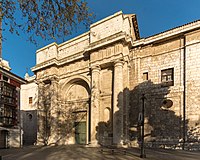Valladolid Cathedral
[1] Initially planned as the cathedral for the capital city of Spain, ultimately only 40-45% of the intended project was completed,[2] due to lack of resources after the court moved towards Madrid, and the expenses caused by the difficult foundations of the building, which was located in an area with a large gap in the field.However, with the newly established episcopal see in the 16th century, the Town Council decided to build a larger, modern cathedral in Renaissance-style, befitting the city's new status.When construction started, Valladolid was the de facto capital of Spain, home to King Philip II and his court.The main chapel and the choir were intended to be in the same place, facing the prayers (following the aims of the Council of Trent), so processions could pass round the back.On the other side of the church, on the third chapel there is a Baroque altarpiece of the 18th century and a group of statues and funerary reliefs of the Venero family, work of a disciple of Pompeo Leoni.




AffiliationCatholic ChurchDistrictValladolidRoman riteYear consecratedProvince of ValladolidCastile and LeónGeographic coordinatesArchitect(s)Juan de HerrerachurchHerrerianRenaissanceSoutheastSpanish Cultural HeritageSpanishCatholiclargest cathedral in EuropeMetropolitan Museum of Arttriumphal archcollegiate churchbishopricepiscopal seePhilip IIMadridChurrigueraNuestra Señora de la AsunciónDoric orderEl EscorialSt. AmbroseSt. AugustineSt. GregorySt. JeromeLisbon earthquakeJuan de JuniSanta María La AntiguaEl GrecoNeoclassicalCain and AbelPompeo LeoniBaroquepipe organDiego Valentín DíazPlaza MayorHoly Week in ValladolidRoman Catholic cathedrals in SpainArchdiocese of BarcelonaBarcelonaSant Feliu de LlobregatTerrassaArchdiocese of BurgosBurgosBilbaoPalenciaVitoria (Old)Vitoria (New)Archdiocese of GranadaAlmeríaCartagenaGranadaGuadixMálagaMurciaArchdiocese of MadridAlcalá de HenaresGetafeMadrid (Old)Madrid (New)Archdiocese of Mérida-BadajozBadajozCáceresMéridaPlasencia (Old)Plasencia (New)Archdiocese of OviedoAstorgaOviedoSantanderArchdiocese of PamplonaCalahorraLogroñoPamplonaSanto Domingo de la CalzadaSan SebastiánTudelaArchdiocese of Santiago de CompostelaFerrolMondoñedoOurenseSantiago de CompostelaArchdiocese of SevilleCádizCórdobaHuelvaLas PalmasSan Cristóbal de La LagunaSevilleArchdiocese of TarragonaGironaLa Seu d'UrgellLleida (Old)Lleida (New)SolsonaTarragonaTortosaArchdiocese of ToledoAlbaceteCiudad RealCuencaGuadalajaraSigüenzaToledoArchdiocese of ValenciaAlicanteCastellón de la PlanaCiutadella de MenorcaOrihuelaPalma de MallorcaSegorbeValenciaArchdiocese of ValladolidÁvilaCiudad RodrigoSalamanca (Old)Salamanca (New)